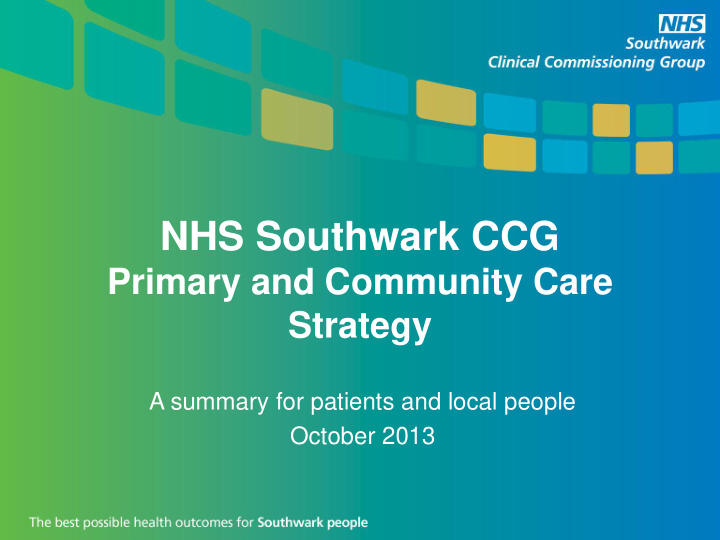



NHS Southwark CCG Primary and Community Care Strategy A summary for patients and local people October 2013
Why does Southwark need this strategy? • NHS Southwark Clinical Commissioning Group is a new organisation which started on 1 April 2013 • We are responsible for organising and paying for a range of health services in Southwark including hospital services and services in community settings • We are also responsible for improving health outcomes for all patients in Southwark, including health services delivered by GP practices • Our strategy describes how the CCG will carry out its responsibilities relating to primary and community care in the new NHS
So why change now? • Primary and community care health services are under pressure • Where appropriate, more services are moving from hospital to community and primary care settings – we need to ensure these work together in an joined up way • There is variability in the quality of service and type of service that patients in different parts of borough receive • We need financially sustainable local health services for our patients • We want a seamless NHS services for patients
How we developed our strategy • We talked to a lot of people in developing our strategy: The Primary and Community Care Strategy Steering Group led this work and included local GP and nurse clinical leads, CCG staff, NHS England, Healthwatch and the Local Medical Committee We held a big public meeting in April with patients, local residents and other key stakeholders We listened to patients views of primary care at Patient Participation Groups and at our Engagement and Patient Experience Committee We talked to local GP practices at our Practice Locality Commissioning Meetings and with the Local Medical Committee and our local clinical GP and nurse leads We engaged with other local stakeholders such as Southwark Council, the Southwark and Lambeth Integrated Care Programme and Community Health services
Key feedback • Patients want to have an extended range of services available at GP practices and pharmacies • Services should be conveniently located and accessible • Patients need to know how to access services and get information to support self management • GPs need not be the only way to be referred to other services • There should be stronger links with other types of care /more integrated services • Not all out of hospital services can be offered in every practice or locality, service models need to take into account efficiency and best use of resources • Need right workforce and IT in place
Strategic objectives From looking at where we are and speaking to practices, patients and other stakeholders we have identified four strategic priorities which address the drivers for change: Extending the range of Integration services Reducing Improving and variation access better care available in coordination the community
Key proposals Locality networks of care • Involves GP practices working together to improve the quality of service and outcomes for the registered population within the locality • Is a way of organising the provision of services in future, particularly additional services which are not commissioned as part of the core GP contract Community specialist clinics / Community hubs • Will provide more out of hospital care closer to patients' homes • Where services can be co-located where this makes good clinical sense and is convenient for patients
How do we make this happen? • We need to support changes to the way that people and services currently work • We need a development programme for GP practices on a locality basis • We need to ensure that there are enough of the right type and appropriately skilled workforce • We need to identify sites where we can provide locality based services and we need to fund these • We need to determine how other community services (e.g. district nurses and health visitors) work with the GP practices to make sure that patients receive the care they need
What does this mean for patients? • Improved access to high quality health care services • More joined-up provision of care for patients who require more than one service • More consistent, better quality services provided to patients • Local GP and community services are better equipped to manage increasing demands on health care services by working better together
Next steps • Agree a programme of work focused on bringing service providers together to deliver health services in a group • Agree what services will be delivered in this way so all patients can access the same core services no matter which practice they are registered at • Start planning for all the above taking into account feedback from patients, practices and other stakeholders
Recommend
More recommend